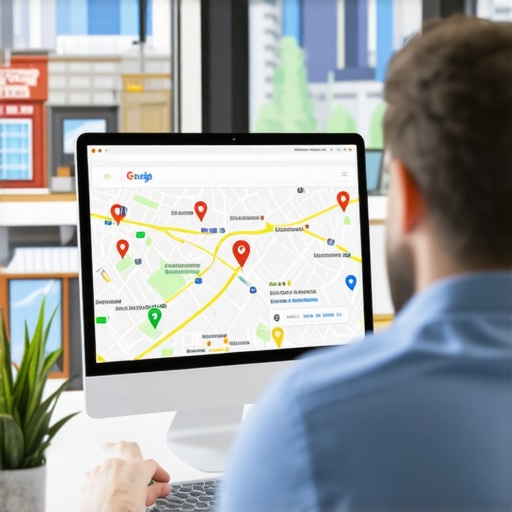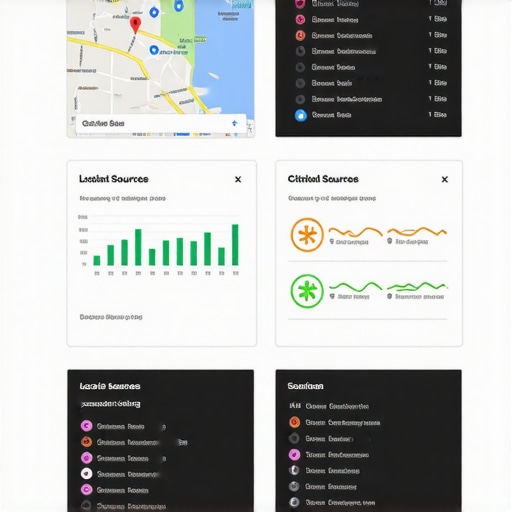My Personal Encounter with Google Maps and the Power of GMB Help
Honestly, I still remember the first time I struggled to get my local business noticed on Google Maps. It was frustrating seeing competitors rank higher despite my efforts. That experience pushed me to explore beyond basic SEO tactics and seek expert support. Over time, I realized that understanding the intricacies of GMB (Google My Business) optimization was crucial. It felt like unlocking a secret level in local SEO, and I was eager to master it.
How I Discovered the True Potential of Google Maps Optimization
After some research, I stumbled upon resources like google-maps-visibility which opened my eyes to advanced strategies. I learned that consistent NAP (Name, Address, Phone number) data, engaging posts, and positive reviews significantly influence rankings. But what truly made a difference was working with expert SEO support. Their tailored advice and technical expertise helped me navigate the often confusing algorithms, making my GMB profile more authoritative and trustworthy.
My Secret Sauce: Combining Tech with Authentic Engagement
One thing I discovered is that technical optimization alone isn’t enough. I had to focus on authentic customer interactions, responding to reviews, and posting regularly. This approach creates a vibrant GMB listing that Google recognizes as active and relevant. I also leveraged tools recommended by reputable sources like the blueprint for GMB optimization to track my progress and stay ahead of competitors.
What Does the Future Hold for Local SEO and GMB?
From my experience, staying updated with the latest Google Maps ranking strategies is vital. Algorithms evolve, and so must our tactics. I highly recommend consulting with experts who understand the nuances of Google’s local search algorithm. Their insights can dramatically improve your visibility, just as they did for me. For those serious about dominating local search, I suggest exploring master GMB help SEO support.
Why is understanding Google’s local algorithm so essential for small businesses?
Because Google’s algorithm prioritizes relevance, distance, and prominence, making it critical to optimize each factor effectively. Ignoring these elements can leave your business invisible to local customers.
If you’re ready to elevate your local presence, I encourage you to share your experiences or ask questions below. Remember, mastering Google Maps rankings isn’t just about technical tweaks; it’s about building trust and visibility in your community.
Why Is Local Relevance the Cornerstone of Google Maps Rankings?
In the intricate world of local SEO, relevance is king. Google aims to connect users with the most pertinent local businesses, which means your Google My Business (GMB) profile must be meticulously optimized for your specific niche and area. This involves not only consistent NAP (Name, Address, Phone) data but also integrating relevant keywords naturally into your profile and posts. For instance, if you run a boutique bakery in downtown, emphasizing keywords like “artisan bakery in downtown” can significantly influence your visibility.
How Can Authentic Customer Engagement Transform Your GMB Profile?
Beyond technical optimization, genuine interactions with customers are vital. Responding thoughtfully to reviews, whether positive or negative, demonstrates active management and builds trust. Google values fresh, user-generated content, so encouraging satisfied customers to leave detailed reviews can enhance your prominence. Regularly posting updates about new products, special offers, or community involvement keeps your listing lively and signals to Google that your business is active and engaged.
What Role Do Advanced SEO Techniques Play in Elevating Your Google Maps Rankings?
Advanced strategies, such as leveraging schema markup, can help Google understand your business better, improving local relevance. Incorporating structured data like LocalBusiness schema boosts your profile’s semantic richness, making it easier for algorithms to recognize your offerings. Additionally, consistent citation management across multiple directories and backlinks from authoritative local sources reinforce your trustworthiness. For comprehensive guidance, exploring innovative SEO techniques is invaluable.
How Do User Experience and Mobile Optimization Impact Your Local Search Performance?
Google prioritizes user experience, especially on mobile devices. A seamless, fast-loading website aligned with your GMB profile encourages visitors to engage and convert. Make sure your website is mobile-friendly, with clear calls-to-action and easy navigation. Google’s algorithms favor businesses that offer a positive user experience, which can lead to higher rankings on maps. Tools like Google’s PageSpeed Insights can help identify and fix issues that may hinder your site’s performance.
What Can You Do Today to Outrank Competitors in Google Maps?
Start by auditing your current GMB profile against authoritative resources like advanced GMB tactics. Focus on consistency in your NAP data, enrich your profile with high-quality images, and regularly update your posts. Engaging with customer reviews and leveraging local backlinks can provide the additional edge needed to outrank competitors. Remember, local SEO is a continuous process—staying updated with algorithm changes and new features is crucial.
Are You Ready to Transform Your Local SEO Strategy?
If you’re committed to elevating your business’s visibility on Google Maps, consider consulting with experts who understand the nuances of local search algorithms. Their insights can help craft a tailored strategy, ensuring your GMB profile reaches its full potential. For more in-depth tactics, explore Google Maps SEO strategies. Share your thoughts or questions below—let’s grow your local presence together!
Deepening My Understanding of Google’s Local Algorithm
As I immersed myself further into Google Maps optimization, I realized that understanding the underlying algorithm was akin to deciphering a complex, ever-evolving puzzle. It’s not just about keywords or reviews anymore; Google’s local algorithm now considers user intent signals, engagement metrics, and even behavioral data, making it crucial to adopt a multifaceted approach. I found that staying ahead requires continual learning and adapting, especially by analyzing insights from tools like Google My Business insights. This knowledge helps identify what’s truly resonating with potential customers and how to refine strategies accordingly.
The Nuanced Art of Local Citations and Their Impact
Beyond the basic NAP consistency, I learned that local citations—mentions of your business across various online platforms—must be strategically managed. Not all citations are created equal; some boost credibility more than others, especially when they come from authoritative local directories or niche-specific sites. I started focusing on building citations from sources that Google considers trustworthy, such as industry associations or local chambers of commerce, which can significantly impact your prominence. For an in-depth look at citation management, I recommend exploring advanced citation strategies.
Visualizing your local SEO efforts through detailed analytics and mapping out citation sources can be transformative. An illustrative map or dashboard can help you track progress and identify gaps in your strategy, making your optimization efforts more precise and data-driven.
How Do You Balance Authentic Engagement with Technical SEO?
One of the most profound lessons I’ve learned is that authentic engagement—like personalized responses to reviews, sharing behind-the-scenes stories, or highlighting community involvement—complements technical SEO. It humanizes your brand and fosters trust, which Google’s algorithm increasingly values. I found that integrating storytelling into my GMB posts not only improved engagement but also contributed to a more vibrant and trustworthy profile. To learn more about creating compelling content, check out strategic content tips.
What Are the Hidden Opportunities in Google Maps Features?
Google Maps offers a suite of features that often go underutilized, like booking integrations, product menus, and special offer posts. Leveraging these can give your business a competitive edge. For example, updating your menu or service list regularly signals active management and relevance to Google, which can boost your rankings. Additionally, features like Q&A allow you to directly engage with potential customers, answering questions that might otherwise deter them. Exploring these lesser-known features can be a game-changer, especially when combined with expert support to ensure optimal setup and ongoing management.
How Can I Use Data to Predict Future Trends in Local SEO?
Data-driven decision-making is at the heart of sustained success. By analyzing patterns in customer reviews, search queries, and engagement metrics, I started to identify emerging trends and shifts in customer preferences. This proactive approach allows me to tailor my content and service offerings accordingly. For instance, a surge in searches for eco-friendly products prompted me to highlight those aspects in my profile and posts. For those interested in mastering this predictive approach, diving into advanced local SEO analytics can provide invaluable insights.
Sharing your experiences or questions about these advanced strategies can be incredibly beneficial. The journey toward mastering Google Maps is ongoing, and learning from others’ insights helps refine our approach. Remember, the key to dominating local search isn’t just technical tweaks; it’s about creating a meaningful, trust-building presence that resonates with your community and leverages every available tool and insight.
Deciphering the Complexities of Google’s Local Algorithm for Elite Rankings
As I delved deeper into the nuances of Google Maps optimization, I realized that the local algorithm is akin to an intricate mosaic, constantly evolving with new signals and ranking factors. Google now integrates behavioral analytics, user intent, and engagement metrics to determine local relevance, making it essential to adopt a holistic approach. For instance, monitoring insights through GMB insights can reveal subtle shifts in customer preferences, guiding strategic adjustments that keep your profile ahead of competitors.
The Strategic Power of Local Citations in Niche Markets
While maintaining NAP consistency remains fundamental, I discovered that targeted citation management across niche-specific directories amplifies your local authority. Prioritizing citations from authoritative industry associations or local chambers of commerce can significantly influence prominence. This strategy not only enhances visibility but also fortifies your trustworthiness in the eyes of Google. For a comprehensive approach, exploring advanced citation tactics is invaluable in refining your local SEO arsenal.
How Can You Leverage Schema Markup for Semantic Superiority?
Implementing schema markup, especially the LocalBusiness schema, transforms your GMB profile into a semantically rich entity. This technical enhancement allows Google to better understand your services, offerings, and geographic relevance. When combined with consistent citations and authentic engagement, schema markup acts as a catalyst, elevating your profile’s prominence. For detailed implementation insights, I recommend reviewing innovative SEO techniques.
Harnessing User Experience and Mobile Optimization for a Competitive Edge
Google’s prioritization of seamless user experiences on mobile devices makes website optimization a critical component of local SEO. Fast-loading, mobile-friendly websites with intuitive navigation and compelling calls-to-action not only improve user engagement but also positively impact rankings. Regular audits using tools like Google’s PageSpeed Insights can identify performance bottlenecks, ensuring your site remains competitive and accessible.
Are You Ready to Deploy Data-Driven Predictive Strategies?
Emerging trends in local SEO point toward the power of predictive analytics. By analyzing customer review patterns, search query trends, and engagement metrics, I’ve started to anticipate shifts in consumer behavior. For example, noticing a rise in eco-friendly product searches prompted me to highlight sustainable practices in my profile and content, which resonated with local audiences. For those eager to harness data effectively, exploring advanced analytics can unlock new levels of strategic precision. I invite you to share your insights or questions—let’s deepen our mastery of Google Maps and elevate your local presence together!
Things I Wish I Knew Earlier (or You Might Find Surprising)
Relevance Over Quantity
Initially, I thought piling up reviews and citations was enough. Turns out, Google values relevance and user intent more than just numbers. Focusing on niche-specific keywords and engaging content made a real difference in my rankings.
Authentic Engagement Matters
Responding to reviews with genuine care and sharing behind-the-scenes stories helped build trust. Google notices active, authentic profiles, which boosts visibility more than automated replies or generic posts.
The Power of Schema Markup
Implementing schema markup, like LocalBusiness schema, transformed my profile’s understanding by Google. This technical tweak enhanced my local relevance and helped stand out among competitors.
Underutilized Features Can Give You an Edge
Features like booking buttons, Q&A, and special offers are often overlooked. Leveraging these tools kept my listing fresh and engaging, which contributed positively to my rankings.
Data-Driven Decisions Are Game Changers
Analyzing insights from Google My Business helped me anticipate customer needs and adapt quickly. This proactive approach kept me ahead in local search results.


